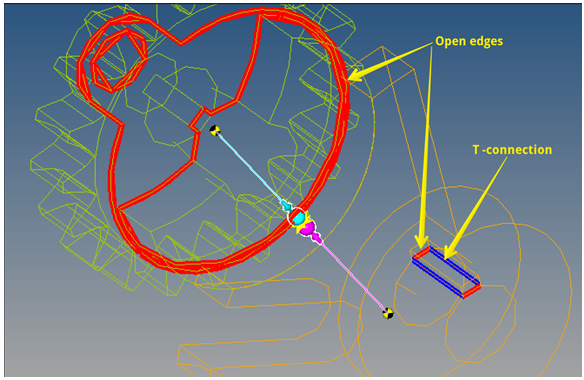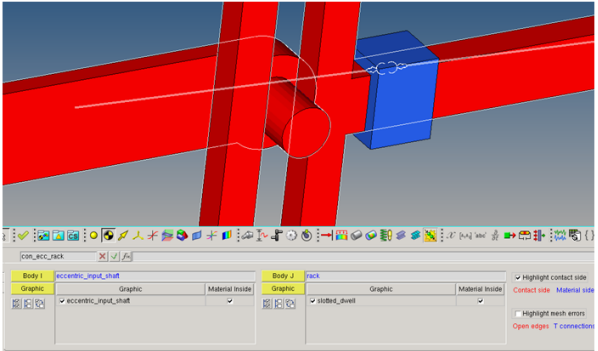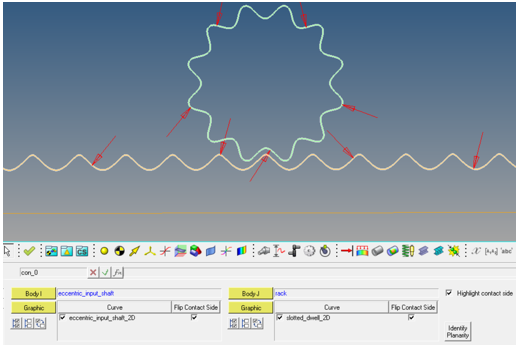Rigid to Rigid Contact
A Rigid to Rigid contact captures contact forces between two rigid bodies moving relative to each other in either a 3D frame or a 2D plane.
Define the Connectivity of 3D Rigid to Rigid Contacts
From the Connectivity, the bodies/graphics involved in the contact can be defined. Checks on graphics for suitability for contacts can also be performed.
-
If the Contacts panel is not currently displayed, select the desired contact by
clicking on it in the Model Browser or in the modeling window.
The Contacts panel is automatically displayed.
- Click the Body I collector and select the first body to define the contact from the modeling window, or double-click the collector to open the Model Tree (from which the desired body can be selected).
- In the same manner, click the Body J collector and select the second body for the contact from the modeling window or Model Tree.
-
For each of the selected bodies, choose the graphics that are involved in the
contact from the list below the body.
All eligible graphics on a body are automatically selected for contacts. Individual graphics may be selected/deselected by using the individual check box located next to each graphic entity in the list.
Alternately, you can click the Graphic collector to activate it and then simply select the desired geometry from the modeling window.
Tip:- The All
 , None
, None  , and Reverse
, and Reverse  options located below the graphic
collector allow you to quickly select the set of graphics you would
like to use for the contact.
options located below the graphic
collector allow you to quickly select the set of graphics you would
like to use for the contact. - Click Material Inside to specify if the graphic has material inside the volume or outside. When this option is selected, it means that the selected geometry is solid. In other words, it is filled with material and its exterior is devoid of material. Consequently, the surface normals of the geometry point outward. When the option is not selected, it means the converse is true: the exterior of the geometry is filled with material and the interior is devoid of material. In this case, the surface normals of the geometry point inward. This flag is useful for reversing the surface normals of a geometry for contact simulations.
- Select Highlight contact side to visualize the direction of the contact of the surface mesh. The side of the surface that would be in contact is indicated by a red color, while the material side is indicated by a blue color.
- Select Highlight mesh errors to visualize any
discontinuities in the surface mesh, such as open edges and
T-connections. An open edge is highlighted through a red line, while
a T-connection is highlighted using a blue line. For better
visibility, the visualization of graphic components involved are
changed to a non-shaded mode.Note: If no mesh errors are found, this option will be disabled and will display No mesh errors.
- The All
Additional Comments:
- In the ADAMS solver mode, if the graphic defined is a File type graphic - it will require an additional parasolid file.
- The individual graphics involved in contact should form a closed volume. In
other words, the graphic mesh should not have any open edges or T-connections.
Use the Highlight mesh errors option to check for open
edges and T-connections.
Figure 1. 
- The normal of the mesh should point in the direction of contact. The side of the
surface mesh, when seen such that the normal direction points towards the viewer
is the contact side. If viewed from the opposite direction, it is referred to as
the material side. Use the Material Inside and
Highlight contact side options in the panel to set
the correct direction of contact. Below is an example of how the Material Inside
and Highlight contact side options work:
Figure 2. 
With both of the graphics having the Material Inside option activated, checking the Highlight contact side option will display the color for both of these graphics in red when viewed from the outside of the graphics.
In certain cases, if the contact direction is on the reverse, the Material Inside flag can be flipped.
Refer to Best Practices for Running 3D Contact Models in MotionSolve to understand more about building models for successful contact simulation.
Define the Connectivity of 2D Rigid to Rigid Contacts
From the Connectivity, the bodies/graphics involved in the 2D contact can be defined. Checks on graphics for suitability for contacts can also be performed.
- Click the Body I collector and select the first body to define the contact from the modeling window, or double-click the collector to open the Model Tree (from which the desired body can be selected).
- In the same manner, click the Body J collector and select the second body for the contact from the modeling window or Model Tree.
-
For each of the selected bodies, choose the graphics that are involved in the
contact from list below the body.
All eligible graphics on a body are automatically selected for contacts. Individual graphics may be selected/deselected by using the individual check box located next to each graphic entity in the list.
Alternately, you can click the Graphic collector to activate it and then simply select the desired geometry from the graphics window.
Tip:- The All
 , None
, None  , and Reverse
, and Reverse  options located below the graphic
collector allow you to quickly select the set of graphics you would
like to use for the contact.
options located below the graphic
collector allow you to quickly select the set of graphics you would
like to use for the contact. - Click Flip Contact Side to to specify the side of the curve graphic which will come in contact. The side of the curve as pointed by the arrow indicates its contact side. Changing this flag will reverse the direction of contact.
- Select Highlight contact side to visualize the direction of the contact of the curve.
- Select Identity Planarity to check the planarity of the curves involved in contact. This tool checks whether the curves are planar and whether the curves are co-planar considering the first selected graphic in Body I as reference.
- The All
- The individual curve graphics involved in 2D contact must use planar curves only. A planar curve has all of its data points in a single plane.
- Currently, MotionView only supports 3D
Cartesian/parametric curves for creating curve graphics that can be used in
2D contact. Below is an example of how the Highlight contact side option
works:
Figure 3. 
The example above shows a rack and a pinion represented with curves and a 2D contact defined between them. The side of the pinion on which the arrows are pointing (which is outside) indicate the side the contact is expected. Similarly, the arrows on the pinion curve have arrows pointing on it from the outside.
In the case where the contact is expected from the opposite side, the Flip Contact Side option can be used.
Define the Properties of Rigid to Rigid Contacts
Parameters for normal and friction force calculations are defined in the Properties tab.
- Click the Properties tab.
- Use the tabs located at the top of the panel to distinguish between a normal force or a friction force.
Normal Forces
This tab is used to set the method and related properties to calculate the normal force during contact. The following four models for defining the normal force are supported: Impact, Poisson, Volume, and User-Defined.
- Click the Normal Force tab.
-
Select the desired method and define the related properties.
If Impact is chosen:If Poisson is chosen:If Volume Model is chosen:If User-Defined is chosen:
Friction Forces
This tab is used to determine the options to include or exclude Coulomb friction in the calculation of the contact force.
- Click the Friction Force tab.
-
Select the desired method and define the related properties.
If Disabled is chosen, friction is turned off.If Dynamic Only is chosen, only dynamic friction or sliding friction is considered in friction calculations. The static regime and transition to sliding is ignored.If Static & Dynamic is chosen, all three regimes are considered in friction calculations: static, transition to sliding friction, and sliding friction.
The steps needed to define Dynamic Only and Static & Dynamic friction are the same:
If User-Defined is chosen:
Define the Advanced Options of Rigid to Rigid Contacts
The Advanced tab provides advanced options to control the contact event during simulation in MotionSolve.
- Click the Advanced tab.
-
Select one or both of the contact event control options.
Option Description Find precise contact event Select this option to tell the solver to capture the first event of contact precisely. Change simulation max step size Select this option to change the maximum step size for the simulation after contact is detected. - If applicable, enter a value for the max step size scale factor.
- Similarly, enter a value for the new max step size.
Note:- Activating Find precise contact event will automatically introduce a sensor entity in the MotionSolve solver deck which will track the contact force function.
- As the sensor is triggered by a positive contact force, the solver rejects the last successful step and proceeds from the previous step size with a changed maximum step size. The changed maximum step size is calculated as (current max step size) * (Max step size scale factor).
- Activating Change simulation max step size will enable changing the maximum step size for the future course of the of the simulation.
- Both of the above options provide increased accuracy and robustness in contact simulations, however they will result in increased simulation times. It is therefore recommended that these options be used selectively and only when necessary.
-
Use the drop-down menu to select where the force will be computed.
Option Description Element Center The contact detection and force calculation in MotionSolve is based on the penetration of mesh element center. This is the default setting. Nodes The contact detection and force calculation in MotionSolve is based on the penetration of mesh nodes.